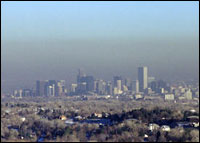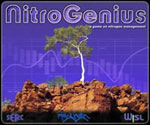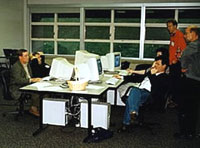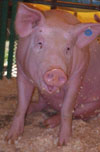Confess: You’ve played more than one hand of solitaire on company time. Tetris anyone? Maybe you’ve even been a MYSTic or a QUAKEr.

If you happen to work for the Dutch Ministry of the Environment, playing computer games is now part of your job description. Or at least playing a computer game — the world’s only computer game designed to solve the problem of nitrogen pollution. The Netherlands is home to intense agriculture and industry, and is, not coincidentally, one of the world’s hot spots for nitrogen pollution.
Nitrogen is a confusing bad guy because it’s everywhere — and often a good guy. You just inhaled a lungful. You ate a bunch for breakfast, then relieved yourself of a bit more. Nitrogen fertilizer radically shaped the course of the 20th century, increasing agricultural output to help feed a growing world population.

The smoggy side of nitrogen oxides.
Photo: NREL.
But then there’s nitrogen’s dark side: Your car combines it with oxygen to form NOx, a component of smog. Nitrogen pollutes surface waters, and in drinking water, it can cause birth defects. We have substantially changed the flow of nitrogen on Earth, and the natural systems of the planet are responding with acid rain, suffocating air, and a massive dead zone in the Gulf of Mexico.
That’s bad news, but it’s hardly the kind of arch-villainy that makes for pulse-pounding, swivel-kicking, search-and-destroy arcade action. But that didn’t deter the computer programmers. At the Second International Nitrogen Conference, held outside of Washington, D.C., last October, the otherwise technical proceedings were spiced up by the official unveiling of NitroGenius, an environmental computer game commissioned by the Dutch government. The hype was palpable; teen-aged boys with nothing better to do than await the Christmas release of the Nintendo Game Cube and Microsoft’s X Box lay siege to the conference.
Okay, that’s stretching it. But to give you an idea of how much nitrogen matters to those in the know, the conference was held barely a month after Sept. 11 and was still attended by more than 400 participants from around the world. And if the plane trip wasn’t enough of a test of faith, we were convened at a Washington-area U.S. Postal Service facility just as the anthrax scare took off.
Make a New Plan, Stan
NitroGenius was born 18 months earlier and 30,000 feet higher, when Stan Smeulders of the Dutch Environment Ministry and Jan Willem Erisman of the Energy Research Center of the Netherlands were winging their way toward the U.S. to help plan the October conference. The pair had helped convene the first such meeting in Noordwijkerhout, the Netherlands, in 1998, thereby beginning the essential but difficult process of getting people who worry about pig farms and manure retention and people who worry about tailpipes and emissions trading to talk to one another.

Image: Play2Learn.
It was a long flight, and somewhere in the middle of it, Smeulders had his big idea: Let’s do something new, he proposed to Erisman, something totally unheard of in nitrogen circles. Smeulders started imagining a game — a game that would help everyone understand the problems associated with nitrogen and the equally thorny challenges of making policy to address those problems; a game everybody could play, perhaps even by joining through the Internet.
“It was a huge idea, of course,” Erisman says. He should know, because it fell to him to implement it. This brings us to the point in the story where many of us proud Americans wish, just for a moment, that we were Dutch. Unfazed by a half-million dollar price tag for a computer game to save the world from nitrogen, the bosses up the political ladder bought in.
Let the Gamers Begin
Fittingly, playing NitroGenius is a little like sitting at a starship console and deciding the fate of small planets. Only, instead of just pointing and shooting, you have to make myriad decisions, taking into account the potential environmental impact of various business and social decisions. It’s a four-person game, with each player representing one sector of the Netherlands: industry, agriculture, government, or society. Each sector can do more or less what it can do in real life: Government can tax, spend, and make policy; society can eat organic and join advocacy groups; agriculture can build green stables or change tillage habits; industry can invest in research and new technology.

Conference attendees playing dirty.
Photo: Play2Learn.
On every turn, each player has a budget and 90 seconds to choose from a series of behavioral options. Graphs show general levels of happiness, employment, and economic health, alongside maps of pollution levels plotted by region. The instruments are recalibrated after every turn.
But beware: Just as you lean in to check your readings, a tomato may hit the screen with a pixilated splat. The first time this happened, we were all startled — even the society representative who “threw” the tomato by exercising her veto power to nix exploratory drilling in a wetlands.
The game is full of pleasant quirks like that, including fake news articles about the discovery of “celestial backspin” and even the occasional advertisement — “Drink Spaz!” — which, when I sat down to play, served to break the ice and get the contestants chatting. From there it was a manure-covered slope to serious gaming. While everybody playing knew something about nitrogen pollution, nobody could go it alone. And nobody seemed to have trouble getting into their roles. “This guy’s spreading cow shit all over the place,” complained one player. Another, a U.S. EPA administrator, declared, “I want to be a radical environmentalist!”
Despite the giggles, the science is hardcore: NitroGenius incorporates state-of-the-art nitrogen modeling by pollution planners in the Netherlands. “The idea of having a game came from the scientific community, and they were focused on providing the right models,” emphasizes Erisman.
But he also got professional game designers involved. “It was a constant struggle between the scientists who wanted to do it right, and the gamers who are not as interested in science. They wanted to play and have fun. What you see here is a compromise.”

Some pig.
Take pig high-rises, for example. I nearly fell off my chair when one of my choices was: “Give permission for a high-rise filled with pigs overlooking the Rotterdam harbor with a central manure-treatment facility and windows with tree paintings for animal welfare. Free of charge!” Sounds funny, but it’s been suggested, says Erisman. “If you look at an aerial photo of the Netherlands, you see all those pig buildings next to each other. It takes up a huge amount of space. So why not build them [up], and place them near the harbors where all the food is imported, and place them near an electricity facility in order to process the organic waste and get all the energy out of it?”Logical, perhaps. But be warned: Build them and the pigs may come, but you’ll take a minus-four image hit.
Real Players
Erisman won’t be jumping to Nintendo, but he does hope to make a single-player version of NitroGenius available for public download soon. And he dreams of virtual reality: “Suppose you could walk through a forest, with the smell, the touch, and the view, and you can change the forest by putting more nitrogen in it. You can see the biodiversity loss. The smell will change. The view will change.”
I like the game the way it is, but then, I won. I even have a windmill trivet to prove it. I’m not expecting an offer to play Nitrogen Czar for the Dutch government, but NitroGenius sure beat the usual conference routine of networking, drinking bad coffee, and fighting the hypnotic influences of PowerPoint.
And that, after all, is the point. Says Erisman: “For me, the strength of the game is not the dataset, it’s not the models. It’s the people who will play it and talk to each other and interact and get an understanding of why someone makes a choice.”
After spending a long, frustrating time trying to get people to look at nitrogen pollution in an integrated fashion, Erisman seems to have finally found the right tool for the job. “It’s the first time they comprehended and saw the need for getting people together,” he laughs. “That’s perfect. Two years of lobbying and talking didn’t do anything. And a game — it works.”


